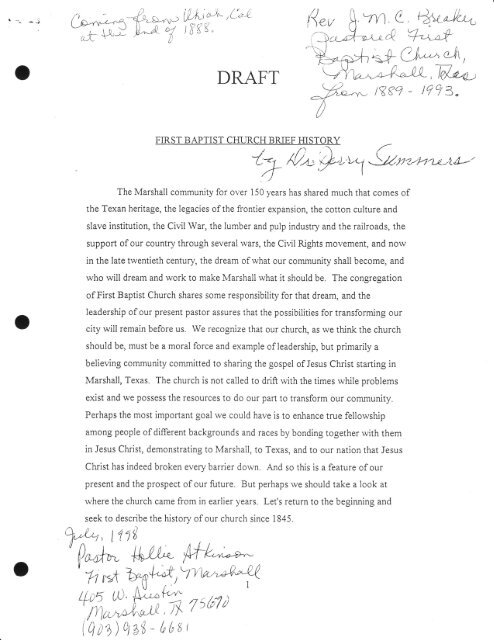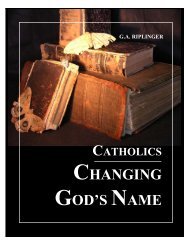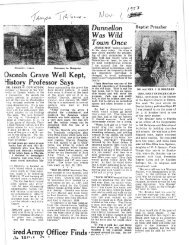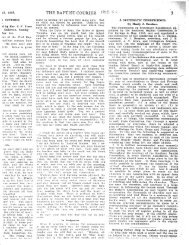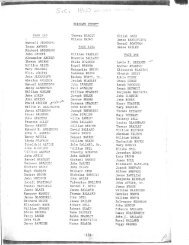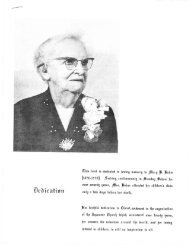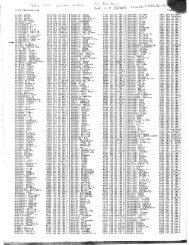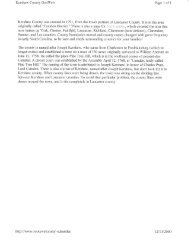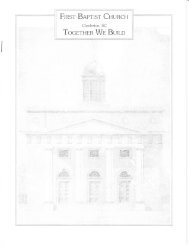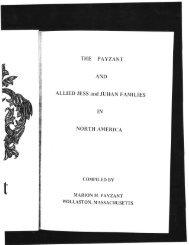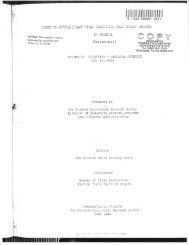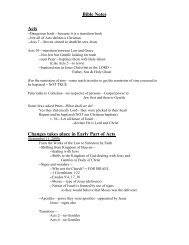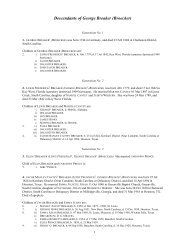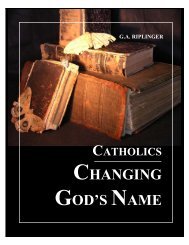Draft of History of First Baptist Church of Marshall, Texas
Draft of History of First Baptist Church of Marshall, Texas
Draft of History of First Baptist Church of Marshall, Texas
You also want an ePaper? Increase the reach of your titles
YUMPU automatically turns print PDFs into web optimized ePapers that Google loves.
-ktrWf#it'c'"!<br />
DRAFT<br />
t /);f-<br />
//t a<br />
FIRST BAPTIST CHTIRCH BRIEF HISTORY<br />
J<br />
-/_t=l<br />
_ M* 4+,U1,-V.)t
Beeinnings in East <strong>Texas</strong><br />
During the period <strong>of</strong> the Republic <strong>of</strong> <strong>Texas</strong> <strong>Baptist</strong>s established churches in<br />
eastern <strong>Texas</strong>, including the first known congregation in Harrison County, at<br />
Border, in 1843, and the Eight-Mile congregation in 1843, now Friendship <strong>Baptist</strong><br />
<strong>Church</strong>. One source cites the presence in 1840 <strong>of</strong> <strong>Baptist</strong>s, Methodists and<br />
Presbyterians meeting in the community that would become <strong>Marshall</strong> in 1841,<br />
suggesting that with the earliest settlement and formation <strong>of</strong> the Republic in the<br />
1830s Christian colonists <strong>of</strong> different denominations would meet jointly for<br />
worship. The <strong>Baptist</strong>s in <strong>Marshall</strong> may have met together with others in union<br />
services for nine years before 1845.<br />
The traditional date <strong>of</strong> founding for <strong>First</strong> <strong>Baptist</strong> <strong>Church</strong> is 1845, the same<br />
year as the annexation <strong>of</strong> <strong>Texas</strong> to the United States and the founding <strong>of</strong> the<br />
Southern <strong>Baptist</strong> Convention in Augusta, Georgia. The best attested date for the<br />
organization <strong>of</strong> <strong>First</strong> <strong>Baptist</strong> <strong>Church</strong> is May 1847, when John Bryce and George<br />
W. Baines, Sr. founded <strong>Marshall</strong><strong>Baptist</strong> <strong>Church</strong>. <strong>Church</strong> members prefer the<br />
1845 date for sentimental and other reasons, among them the conviction that a<br />
<strong>Baptist</strong> congregation <strong>of</strong> some sort had existed in the community even before the<br />
formal organization <strong>of</strong> <strong>Marshall</strong> in 1841, and that the constitution <strong>of</strong> the church in<br />
1847 reflected the efforts <strong>of</strong> John Bryce as a pastor and missionary under<br />
assignment <strong>of</strong> the recently formed Southern <strong>Baptist</strong> Convention, rvith which the<br />
church cooperated after i847.<br />
Even with the formal organization <strong>of</strong> the church under Pastor John Bryce,<br />
the congregation met under his leadership only once a month during the period<br />
before Jesse Witt succeeded him as pastor in 1849. Bryce, who made his home in<br />
Shreveport, had pastored churches in his home state <strong>of</strong> Virginia, had held<br />
appointment as master <strong>of</strong> chancery in the court <strong>of</strong> John <strong>Marshall</strong>, Chief Justice <strong>of</strong><br />
the Supreme Court and namesake <strong>of</strong> <strong>Marshall</strong>, <strong>Texas</strong>, and from sometime in 1843<br />
had served under appointment <strong>of</strong> President John Tyler in the secret negotiations<br />
with Mexico for annexation <strong>of</strong> <strong>Texas</strong>. During his stay in Shreveport he was briefly
"l<br />
mayor <strong>of</strong> that city in 1849, and served in the founding <strong>of</strong> numerous churches in<br />
Shreveport and the surrounding region. At the time he was the part-time pastor <strong>of</strong><br />
the <strong>Marshall</strong> <strong>Baptist</strong> <strong>Church</strong>, he was serving the <strong>First</strong> <strong>Baptist</strong> <strong>Church</strong> <strong>of</strong><br />
Shreveport which he had led to start on March 18, 1845. [Paxton, 356] Bryce<br />
ended his pastoral career in Henderson, Kentucky, where he died in July 1864.<br />
George Washington Baines, Sr., like Bryce, also made his home in<br />
Louisiana, where he continued the pattern he had established long before <strong>of</strong><br />
helping to plant churches. <strong>First</strong> in Arkansas, then in Louisiana, and ultimately in<br />
<strong>Texas</strong> from 1849 to the end <strong>of</strong> his life in 1884 tttlll he started and helped to start<br />
many churches and pastored. In <strong>Texas</strong> Baines founded the <strong>Texas</strong> <strong>Baptist</strong>, and in<br />
the 1860s succeeded RuE'5 Burleson as president <strong>of</strong> Baylor University at<br />
Independence, serving two years before the university was moved to Waco,<br />
Baines was the great-grandfather <strong>of</strong> Lyndon Baines Johnson. tttlll<br />
-{-<br />
)t I<br />
The Earliest Members<br />
'."-\<br />
,v'J<br />
The congregation met during the first two years <strong>of</strong> its existence in the<br />
,N ^-,^r^^Lr^^L,.:rr:-^^f+L^rr^-^-:^rl^-^r^..^-:..^-- ---L:^L --^- -tL- ,^L-.-t:-^<br />
original log building <strong>of</strong> the Masonic Female Seminary, which used<br />
o l-{'<br />
to stand in the<br />
'4"<br />
two-hundred block <strong>of</strong> West Burleson Street, The first members included Dr.<br />
William Evans, Mrs. Garrison, I\4rs. McCown, Mrs. Van Zandt, and the J.D. Scott<br />
' family. lzIrs, Van Zandt's husband, fsaac, appointed by President Sam Houston as<br />
Plenipotentiary to the United States from the Republic <strong>of</strong> <strong>Texas</strong>, ran for the<br />
governorship in 1847, but died <strong>of</strong> yellow fever during the campaign. The<br />
missionary William Tryon [[[]l]<br />
preached Van Zandt's funeral at <strong>First</strong> <strong>Baptist</strong><br />
<strong>Church</strong>, not long before his own death <strong>of</strong> yellow fever in November 1847. Dr.<br />
Evans, <strong>Marshall</strong>'s first practicing physician, had a brother, Lemuel Dale, rvho<br />
served on the <strong>Texas</strong> Supreme Court from i848 to 1852, and *'as a U.S.<br />
Representative from 1857 to 1859. Dr. Evans's daughter, Martha, married<br />
Edward Clark, <strong>Texas</strong>' first Civil War governor.
The second pastor, Jesse Witt, looked the patriarch with his long, florving,<br />
white beard, and he inspired confidence through his excellent preaching. The<br />
church had four pastors during its first decade, including Bryce, Witt, George<br />
Tucker, and William Stokes. During that decade the congregation grew along<br />
with the town, and the church received a grant <strong>of</strong> land from the Tennessean, James<br />
McCown, who came to <strong>Texas</strong> in 1841, and <strong>Marshall</strong> in i843, and was among the<br />
members <strong>of</strong> the first <strong>Texas</strong> legislature in 1846. In 1892 the heirs <strong>of</strong> James<br />
McCown filed a formal deed <strong>of</strong> the church property to <strong>First</strong> <strong>Baptist</strong> <strong>Church</strong>; until<br />
then McCown's oral grant <strong>of</strong> the land had sufficed.<br />
The first house <strong>of</strong> worship rose on the property in 1849, and the <strong>Baptist</strong>s<br />
shared the building with other denominations. Imagine worshipping in a rvooden<br />
church building lighted with oil lamps, or being baptized in its baptistry that rvas<br />
filled with cold well water. A reed organ supplied music. The union Sunday<br />
School was every Sunday, and the ministers <strong>of</strong> the different denominations<br />
preached on alternating Sundays. The building also allowed the townspeople to<br />
attend various civic and cultural functions indoors. The slaves sat to the rear as<br />
was the custom in churches throughout the South, and but eventually some years<br />
after the Civil War the black freedmen established their orvn congregations. The<br />
first <strong>of</strong> these, the Colored <strong>Baptist</strong> <strong>Church</strong>, with the help <strong>of</strong> A.E. Clemmons, in<br />
1867 became the Bethesda <strong>Baptist</strong> <strong>Church</strong>. The Rev. William Massey, rvho<br />
arrived in <strong>Marshall</strong> in 1865 from Virginia, was the first pastor <strong>of</strong> Bethesda <strong>Baptist</strong><br />
<strong>Church</strong>.<br />
A.E. Clemmons, the fifth pastor <strong>of</strong> <strong>First</strong> <strong>Baptist</strong> <strong>Church</strong> and active<br />
missionary-pastor in Louisiana over the years, sen'ed five different terms as pastor<br />
between 1858 and 1888. This outstanding preacher and civic leader became the<br />
founding pastor <strong>of</strong> <strong>First</strong> <strong>Baptist</strong> <strong>Church</strong> in Longvierv in i870.<br />
Betrveen 1858 and 1893, <strong>First</strong> <strong>Baptist</strong> had a succession <strong>of</strong> nine pastors<br />
including A.E. Clemmons and the last, Dr. J.M.C. Breaker, a nationally-knorvn<br />
speaker who, like Clemmons, was a member <strong>of</strong> the Masonic order. His son,
-*:'ffi#;TEffi-<br />
/*f<br />
J.M.C. Breaker, Jr., donated his architectural design work for the new church<br />
building that was completed in 1892, not long before Dr. Breaker resigned due to<br />
illness and soon died.<br />
Completed at a cost <strong>of</strong> $10,000 in 1892, the Gothic-style nerv building<br />
strikes a notable silhouette in early twentieth-century photographs <strong>of</strong> lr{arshall.<br />
The new building received a distinctive character in its interior when the next<br />
pastor, John Holland, applied his hand <strong>of</strong> artistry to painting frescoes <strong>of</strong> biblical<br />
scenes on the walls and on the curtain behind the baptistry. The Union army<br />
confiscated the church bell from the belfry during the post-Civil War military<br />
i<br />
I<br />
occupation <strong>of</strong> <strong>Marshall</strong>. Its replacement was cast containing eighty silver dollars in<br />
order to give it a bright tone.<br />
During the turn-<strong>of</strong>-the-century period, five pastors sen'ed the church, Dr,<br />
t<br />
I<br />
I<br />
I<br />
M.T. Andrews (1898-1902), E.L. Wesson (1903-1904), M.E. Weaver (1904-<br />
1908), Robert Wilson (1908-1909), and A.A. Duncan (1910). The congregation<br />
already was large enough to provide Sunday School and B.Y.P.U. activities for the<br />
adult, senior, intermediate, junior and primary levels. The u'omen's Mitchell Aid<br />
Society, founded in 1884 while Dr. w.J. Mitchell was pastor, became the w.M.S.<br />
Auxiliary in 19i5. Then, much as now, the women's mission organization<br />
facilitated a missions prayer and giving ministry, mission study, and mission<br />
education for children: Sunbeams, Girls in Action, Junior Y.W.A., and Royal<br />
Ambassadors.<br />
William T. Tardy, the pastor from 19l0 to 1914, led in the effort to<br />
orgarttze the College <strong>of</strong> <strong>Marshall</strong>, a two-year institution that norv is East <strong>Texas</strong><br />
<strong>Baptist</strong> University.<br />
[optional][[[Chartered January 27, 1912, the College <strong>of</strong> ]r{arshall<br />
fulfilled the longstanding desire <strong>of</strong> <strong>Marshall</strong>ites to have an<br />
institution <strong>of</strong> higher education, and the college's founding revealed<br />
the spirit <strong>of</strong> cooperation as members <strong>of</strong> other denominations<br />
contributed to it. <strong>History</strong> has it that the first two one thousand-
dollar gifts came from Methodist laymen Marvin Turney and P.G.<br />
Whaley. Tardy located a prime situation for the College <strong>of</strong><br />
<strong>Marshall</strong> campus on Van Zandt hill and negotiated the purchase <strong>of</strong><br />
one hundred acres from the YanZandt heirs. On that hillthere rose<br />
the main campus building, <strong>Marshall</strong>Hall, a four-story brick<br />
structure built in l9l6 for $80,000 under the presidency <strong>of</strong><br />
Thurman C. Gardner. Colleee <strong>of</strong> <strong>Marshall</strong> classes beean in June<br />
l e l7.lll<br />
Throughout its history the college, now the university, has had close ties to <strong>First</strong><br />
<strong>Baptist</strong> <strong>Church</strong>. The church counts among its present and former members<br />
presidents, trustees, faculty and many students.<br />
Rev. Tardy died in 1914 following a long illness. During his illness Rev.<br />
C.P. Morris served as supply pastor, and then went on to serve as a missionary in<br />
China. During the last ferv months <strong>of</strong> i9l4 and part <strong>of</strong> 1915 Rev. R.L. Baker<br />
served as pastor, but left to serve in Louisiana. During the World War I years<br />
(1916-1920) Rev. Marion E. Hudson pastored, but took a year's leave to pursue<br />
ministry with the Young N,Ien's Christian Association in France. During his<br />
absence the church enjoyed the weekend supply preaching <strong>of</strong> Rev. B.A. Copass, a<br />
pr<strong>of</strong>essor from Southwestern Seminary in Fort Worth. Hudson, after leaving<br />
<strong>Marshall</strong> to serve in El Paso, later returned to <strong>Marshall</strong> as president <strong>of</strong> the College<br />
<strong>of</strong> <strong>Marshall</strong>. G.J. Rousseau served the church from 1921 to 1925, and led <strong>First</strong><br />
<strong>Baptist</strong> to be one <strong>of</strong> three churches in <strong>Texas</strong> to exceed their pledges to the<br />
$75,000,000 campaign for missions. The growth <strong>of</strong> the church necessitated the<br />
building <strong>of</strong> temporary space for Sunday School and training union use. Following<br />
the brief but admirable service <strong>of</strong> Dr. Tillman D. Johnson as pastor in 1924, Rev.<br />
S.H. Frazier became pastor and continued to lead church growth and the fundraising<br />
campaign for a new educational building.<br />
Dr. Harlan Matthews (1928-1942) ttt???lll<br />
6
During the brief interim pastorate and pastorate (1942-1945) <strong>of</strong> Dr. W.H.<br />
Simms, <strong>First</strong> <strong>Baptist</strong> lost several dozen members who formed a new church,<br />
Central <strong>Baptist</strong>.<br />
We are indebted to former pastor William J. Fritts for his brief history,<br />
Arthur B. Rutledee. The Glory Years, concerning the pastor whose ministry to<br />
<strong>First</strong> <strong>Baptist</strong> <strong>Church</strong> began as the United States was accomplishing victory in the<br />
Pacific in August i945. A.fter twelve years as pastor, Rutledge was to serve as<br />
secretary <strong>of</strong> Stewardship and Direct Missions for the <strong>Baptist</strong> General Convention<br />
<strong>of</strong> <strong>Texas</strong>, as Director <strong>of</strong> the Division <strong>of</strong> Missions for the Home Mission Board,<br />
1959 - 1965, and as Executive Director-Treasurer <strong>of</strong> the Home Mission Board<br />
from 1965 ta 1976.<br />
Coming to <strong>First</strong> <strong>Baptist</strong> as he did, Dr. Rutledge led the church past the rift<br />
out <strong>of</strong> which there had come the Central <strong>Baptist</strong> <strong>Church</strong>. Then as norv the average<br />
age <strong>of</strong> the church membership was older than the norm for a <strong>Baptist</strong> <strong>Church</strong>.<br />
Nonetheless, Dr. Rutledge and his partner in rninistry and life, Vesta, led by<br />
example in service and in openness to people <strong>of</strong> allwalks <strong>of</strong> life and race in the<br />
<strong>Marshall</strong> community. Under his leadership and preaching, the <strong>First</strong> <strong>Baptist</strong> <strong>Church</strong><br />
<strong>of</strong> the 1950s thrived as never before and rarely since, partly due to the intense<br />
spiritual emphasis <strong>of</strong> the post-World War II period, but surely also as a result <strong>of</strong><br />
the opportunities for study, u'orship, fellowship, and spiritual grorvth in <strong>First</strong><br />
<strong>Baptist</strong> <strong>Church</strong>. The church commenced use <strong>of</strong> the new children's building in<br />
I 955.<br />
AIso during the 1940s and 1950s <strong>First</strong> <strong>Baptist</strong> <strong>Church</strong> through Sunday<br />
School extension and mission sponsorship helped to start five churches: Hillcrest<br />
<strong>Baptist</strong> Mission (1945), East End <strong>Baptist</strong> Mission (1948), Immanuel <strong>Baptist</strong><br />
<strong>Church</strong> (1947),Clearview <strong>Baptist</strong> Mission (1957) and Parkview <strong>Baptist</strong> Mission<br />
(l e5o).<br />
Marion M. Harris came as pastor in 1958, serving until 1967 when he<br />
entered full-time evangelism. During the 1960s the church added educational
space, and until the public schools began a kindergarten program, the church<br />
operated a kindergarten. Dr. Connie Ward came in 1968 as pastor and exercised a<br />
conciliatory, strenglhening ministry within the church fellowship. IFF\batmore.tr---<br />
---say-about the contentions <strong>of</strong> the 1960s?--What-say'ye.longtime members?]]l In<br />
I972 the church received a big boost when the new educational building was<br />
complete, and its classroom space could satisfo the space needs <strong>of</strong> the Sunday<br />
School. The chapel provided another useful meeting place. The church grappled<br />
with the issue <strong>of</strong> granting membership to black Christians in the 1970s, finally<br />
voting in I974 to permit blacks to become members. Ida Slone reported that from<br />
the time <strong>of</strong> the vote thirteen years elapsed before the church received the first black<br />
member through pr<strong>of</strong>ession <strong>of</strong> faith and baptism. During the 1970s <strong>First</strong> <strong>Baptist</strong><br />
promoted the city-side revival, "Festival <strong>of</strong> Faith," members participated in<br />
volunteer missions, the church increased giving to the Cooperative Program,<br />
Domingo Arriaga served as the pastor <strong>of</strong> a Hispanic mission <strong>of</strong> <strong>First</strong> <strong>Baptist</strong>, and<br />
large numbers <strong>of</strong> ETBC students vitalized the church through study and<br />
fellowship, missions and ministry.<br />
Dr. William J. Fritts served as pastor from 1978 to 1984. His ministry was<br />
a calming influence on the church and he Ieft the church stronger and more united.<br />
During this time Dr. Fritts authored a booklet entitled The Glory Years , a brief<br />
history <strong>of</strong> the ministry <strong>of</strong> Arthur B. Rutledge with the <strong>First</strong> <strong>Baptist</strong> church <strong>of</strong><br />
<strong>Marshall</strong>, <strong>Texas</strong>. Under Dr. Fritts' leadership the church progressed through a<br />
Capital Improvement Project valued at approximately $150,000. Beginning in<br />
1983 with Sam R. Moseley as Chairman, this project provided, among other<br />
things, paving for the east parking lot, a green metallic storage building there, a<br />
remodeled <strong>of</strong>fice area and kitchen, improvements in the foyer and the classrooms<br />
above it, additional equipment in the Children's Building, and much needed<br />
maintenance work on the worship center.<br />
Dr. Fritts led the church on a variety <strong>of</strong> special events. One such was on<br />
July 3, 1983, when the Sunday morning worship service was declared to be an "I
!:<br />
Love America" celebration. The church bulletin for that service contained copies<br />
<strong>of</strong> letters from President Ronald Reagan, <strong>Texas</strong> Governor Mark White, United<br />
States Congressman Sam B. Hall, Jr., and <strong>Marshall</strong> Mayor Lane Strahan,<br />
declaring their favorite hymn. These letters came in response to a letter request<br />
from Harry Matthews, the Minister <strong>of</strong> Youth and Music. These favorite hymns<br />
were made a part <strong>of</strong> the worship service.<br />
Following the interim pastorate <strong>of</strong> Dr. James Taylor, Dr. Hoilie Atkinson<br />
began his service in December 1984, in a church that seems to have been<br />
struggling with its concept as a fellowshipping body and as a center <strong>of</strong> missions<br />
and ministry. Over the past ten years Dr. Atkinson has provided strong service as<br />
a preacher and counselor, and time will reveal how he has successfully led the<br />
church to consistency <strong>of</strong> commitment in witness in our community, involvement in<br />
missions and ministry tkough action and stewardship, through efforts to promote<br />
healing and fellowship among Christians in our community that has been racially<br />
divided for so long. <strong>First</strong> <strong>Baptist</strong> <strong>Church</strong> has enjoyed financial stability and growh<br />
in membership over the past several years, despite the remaining indebtedness<br />
incurred from the necessary renovation <strong>of</strong> the church worship center following the<br />
structural failure <strong>of</strong> the ro<strong>of</strong>. <strong>First</strong> <strong>Baptist</strong> <strong>Church</strong> enjoys a strong, stable<br />
fellowship, but as during former years still must deal with the peculiar problems<br />
and opportunities associated with a membership well above the Southern <strong>Baptist</strong><br />
norm in average age. The church stands strong because <strong>of</strong> the maturity and<br />
stability <strong>of</strong> its teachers, its committed leadership in the deaconate and in the<br />
committees, its consistent prayer ministry, and the commitment <strong>of</strong> its longtime<br />
core membership to the church and the <strong>Marshall</strong> community.


